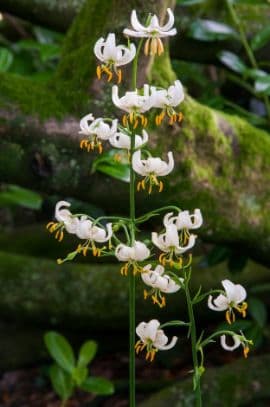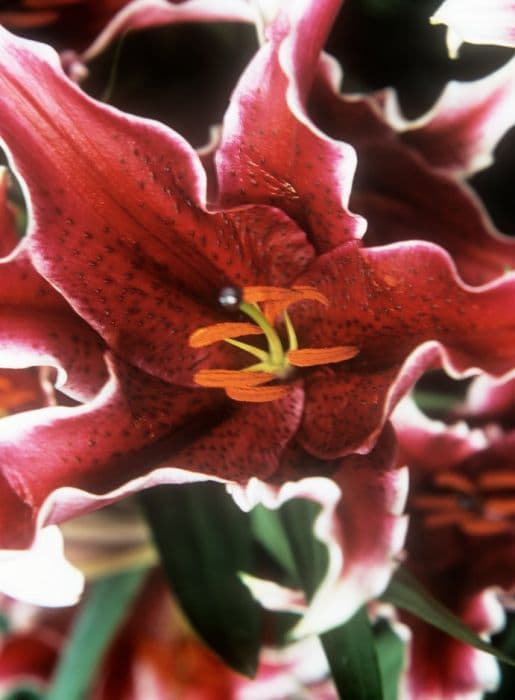Tulip Tulipa 'Marjolein' (6)

ABOUT
Tulipa 'Marjolein' is commonly known as a tulip. This particular variety showcases a distinctive appearance with its captivating flower form and coloration. The tulip blooms present a cup-shaped silhouette, which is typical of this species, often displaying a showy and attractive look. The petals of the Marjolein variety are noted for their resplendent colors—often a mix of soothing pastel shades that may include soft pinks, creamy whites, or subtle purples that elegantly blend together. The outer petals might exhibit a slightly different hue or intensity of color, giving the flower a multi-dimensional and textured appearance. Each petal typically has smooth margins and a lustrous, almost waxy surface that reflects sunlight in the garden, creating a gentle sheen. When the bloom is fully open, the inner parts of the flower, including the stamens and pistil, are exposed, providing a contrasting look that attracts the attention of pollinators. The foliage of the Marjolein tulip is also distinctive, with broad, lance-shaped leaves that have a rich green color. These leaves usually form a low clump at the base of the flower stem, offering a lush backdrop that further accentuates the beauty of the blossoms perched atop the slender stems. The leaves may sometimes bear a slightly wavy or ruffled edge, adding to the overall aesthetic of the plant. Overall, the Marjolein tulip is a stunning plant that brings a touch of elegance and refined beauty to any setting in which it is grown.
About this plant
 Names
NamesFamily
Liliaceae.
Synonyms
Tulip.
Common names
Tulipa 'Marjolein'
 Toxicity
ToxicityTo humans
Tulips are not highly toxic to humans, but they can cause mild irritation. If ingested, parts of the tulip can cause symptoms such as nausea, vomiting, diarrhea, and dizziness. It is the bulb that is the most toxic part, but it is unlikely to cause severe poisoning unless consumed in large quantities.
To pets
Tulips are toxic to pets, particularly the bulb, which contains allergenic lactones and other compounds. If ingested by a pet, such as a cat or dog, symptoms can include vomiting, diarrhea, drooling, and in severe cases, an increase in heart rate and changes in breathing. Medical attention should be sought if a pet consumes any part of a tulip plant, especially the bulb.
 Characteristics
CharacteristicsLife cycle
Perennials
Foliage type
Deciduous
Color of leaves
Green
Flower color
Pink
Height
1 feet 6 inches (45.72 cm)
Spread
0 feet 6 inches (15.24 cm)
Plant type
Bulb
Hardiness zones
3
Native area
Central Asia
Benefits
 General Benefits
General Benefits- Enhances Landscape Aesthetics: Tulipa 'Marjolein' adds vibrant color and visual interest to gardens with its colorful blooms.
- Attracts Pollinators: The flowers can attract bees and other pollinating insects, aiding in the pollination of nearby plants.
- Seasonal Interest: Provides a distinct and attractive look during its blooming season, which can be a highlight in spring gardens.
- Ease of Cultivation: Tulips are generally easy to grow and can thrive in a variety of soil types with minimal care.
- Versatility in Landscaping: Can be used in flower beds, borders, containers, and as cut flowers for indoor decoration.
- Symbolism and Cultural Significance: Tulips carry various meanings and can be used to express sentiments such as love and cheerfulness in cultural practices.
 Medical Properties
Medical PropertiesThis plant is not used for medical purposes.
 Air-purifying Qualities
Air-purifying QualitiesThis plant is not specifically known for air purifying qualities.
 Other Uses
Other Uses- Tulips like 'Marjolein' can be used in eco-friendly fabric dyeing, providing a range of natural colors from their petals.
- Petals of the tulip can be added to salads or used as a garnish for their slight sweetness and crisp texture.
- The sturdy stems can be utilized in light crafts or as natural supports for other plants in the garden.
- Tulip bulbs have been historically used as a replacement for onions in cooking during times of scarcity.
- Pressed and dried tulip petals retain their color well and are ideal for creating botanical art or herbarium sheets.
- Tulips can be used as a natural pest repellent; certain compounds in the bulbs and flowers can deter moles and voles.
- The vibrant colors of tulips can be utilized in photography to provide a compelling and colorful backdrop or subject.
- When dried, the seeds from the tulip can be used in homemade potpourris or as filling for scented sachets.
- Used in float therapy, tulip petals can float on water surfaces, enhancing the visual experience in relaxation spas.
- Tulip flowers can be crystallized with sugar and used to decorate cakes or desserts, providing an elegant and edible touch.
Interesting Facts
 Feng Shui
Feng ShuiThe tulip is not predominantly used in Feng Shui practice.
 Zodiac Sign Compitability
Zodiac Sign CompitabilityThe tulip is not used in astrology practice.
 Plant Symbolism
Plant Symbolism- Perfect Love: The tulip is often regarded as a symbol of perfect love, epitomizing deep and unconditional feelings.
- Rebirth: With their spring bloom, tulips represent the idea of renewal and the coming of fresh beginnings.
- Charity: Tulips, particularly those in lighter shades, can be associated with altruism and caring for others.
- Forgiveness: Offering a tulip can be seen as a gesture of seeking forgiveness or mending relationships.
- Eternal Life: Dating back to Turkish and Persian legends, the tulip can symbolize immortality and the divine.
- Royalty and Wealth: In the 17th century, tulips were a precious commodity and thus became associated with wealth and the upper classes.
 Water
WaterTulips require moderate watering and should be watered thoroughly when the soil feels dry to the touch. During the growing season, water your 'Marjolein' Tulip every few days to keep the soil evenly moist but not waterlogged, providing about 1 gallon per square yard every week. Once the foliage has died back after blooming, reduce watering to allow the soil to dry out as the bulbs enter a dormant period.
 Light
LightFor the best growth, place 'Marjolein' Tulips in a spot with full sunlight during the spring blooming season. They thrive with at least 6 hours of direct sunlight daily. Afternoon shade can be beneficial in hotter climates to prevent the blooms from fading too quickly.
 Temperature
Temperature'Marjolein' Tulips prefer cooler temperatures and will bloom best when night temperatures are between 40 and 50 degrees Fahrenheit. They can survive winter temperatures down to 20 degrees Fahrenheit but should not be exposed to prolonged periods of heat above 70 degrees Fahrenheit. The ideal temperature range for these tulips is between 40 and 70 degrees Fahrenheit.
 Pruning
PruningPruning 'Marjolein' Tulips involves deadheading spent flowers after blooming to prevent seed formation, which can deplete the bulb's energy. However, leave the foliage in place until it yellows and dies back naturally, typically about 6 weeks after blooming, to allow the bulb to store energy for next year's growth. Pruning is not needed at other times.
 Cleaning
CleaningAs needed
 Soil
SoilTulips, including the 'Marjolein', thrive in well-draining, sandy loam soil with a neutral to slightly acidic pH of 6.0 to 7.0. A mix of two-thirds garden soil to one-third river sand or perlite can achieve the ideal texture. Adding compost or well-rotted manure will provide nutrients for optimal growth.
 Repotting
RepottingTulips, such as the 'Marjolein', are perennial bulbs and do not need to be repotted regularly. Instead, they should be lifted and divided every 3-5 years after the foliage has died back to prevent overcrowding and to maintain vigor.
 Humidity & Misting
Humidity & MistingTulips like 'Marjolein' prefer moderate humidity conditions. They tolerate the average outdoor humidity well and do not require specific humidity adjustments when planted in garden beds or borders.
 Suitable locations
Suitable locationsIndoor
Place 'Marjolein' tulips in bright, indirect light.
Outdoor
Plant 'Marjolein' tulips in fall; full sun or partial shade.
Hardiness zone
3-8 USDA
 Life cycle
Life cycleThe life of a Tulipa 'Marjolein', commonly known as Tulip, begins with a dormant bulb that is typically planted in the fall before the onset of cold weather. In the spring, the bulb breaks dormancy and sprouts, sending up a shoot that will develop into a stem and leaves. As the plant matures, a bud forms and eventually blooms into a single, colorful flower, characteristic of tulips. After flowering, the plant focuses on energy storage, with the foliage photosynthesizing to replenish the bulb for the next growing season. Once the leaves yellow and die back, the plant enters dormancy again during the summer months. The cycle repeats annually, with the bulb remaining dormant underground until the next spring triggers a new growth cycle.
 Propogation
PropogationPropogation time
Spring
Tulips, including the Tulipa 'Marjolein' variety, are predominantly propagated through bulb division. This is usually carried out in the fall, just before the onset of the winter cold. During this time, the bulbs are dormant, which makes it the opportune moment to dig them up and handle them without causing damage to the plant. The propagation process involves carefully unearthing the mature bulbs and gently separating the smaller bulbs, which are referred to as offsets, from the parent bulb. These offsets can then be replanted immediately to establish new plants. The depth at which the bulbs should be planted is roughly three times their height, ensuring that the pointy end faces upwards. This method leverages the plant's natural reproductive cycle and does not require any special equipment or complex horticultural techniques.





![Lily [Roselily Chelsea]](/_next/image?url=https%3A%2F%2Fplants-admin.emdemapps.com%2Fimages%2Fplants%2F%2Fimages%2F604b584f6f830.png&w=640&q=75)



